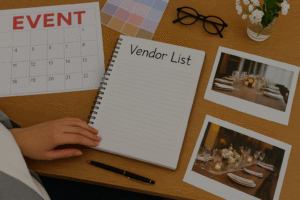
Want to fast track your own list? Visit our directory.
The most successful event planners have a trusted network of vendors, from caterers and florists to photographers, AV technicians, and beyond. A planner’s vendor list is essential to creating premium client experiences, so how do you create a well-curated list? Whether you’re building from scratch, or simply looking to improve your existing partnerships, this article will help you understand how to build, refine, and maintain a high-quality vendor list that will reassure all of your clients you are a trusted source for quality experiences.
1. Start With Your Event Goals and Client Needs
Before you begin compiling names, make sure you understand your typical client base and the types of events you plan to specialize in. A wedding planner’s vendor list will look very different from that of a corporate or nonprofit planner. Think about the services your clients typically need, and whether you should focus on luxury, budget-conscious, or specialty vendors – or a combination of all three.
The better you understand your goals and client expectations, the more strategic and effective your vendor list will be.
2. Use Local Industry Networks and Associations
One of the easiest ways to find reputable vendors is through your local event industry networks. Join associations and groups that connect planners with service providers, such as Choose Chicago, ILEA, MPI, NACE, SITE Chicago, or your neighborhood Chamber of Commerce.
Attend trade shows and networking events where vendors are showcasing their work. These in-person opportunities will give you a chance to assess professionalism, communication style, and whether the vendor aligns with your brand values.
3. Get Recommendations from Fellow Planners
Planners who have been in the business for years are one of your most valuable sources of information. The best recommendations often come from people who have worked with vendors repeatedly and can vouch for their work. Real feedback from actual events can give you insights that online reviews and social media posts simply can’t offer.
As important as it is to get good referrals, it is also useful to know what vendors to stay away from. If you hear the same negative feedback about a vendor more than once, it may be worth reconsidering their involvement in any of your future events. You do not want to hire an unreputable vendor who could ruin your client’s experience, and your own reputation.
4. Do a Vendor Audit Before Adding Anyone to Your List
Instagram feeds and beautiful branding can be appealing, but that is not enough. Before adding anyone to your list, do a thorough audit of their business. Ask for references, read online reviews, and request a portfolio of real event work. Confirm they are properly licensed and insured, especially for high-risk categories like catering, bar service, AV, or transportation.
Pay attention to how they communicate. Are they professional, prompt, and clear? Can they adapt to last-minute changes or offer solutions under pressure? These qualities matter when you’re onsite and under a deadline. The time you take to vet a vendor now can save you from potential chaos later on.
5. Diversify Your Vendor Options
Relying on one vendor per category can put your event at risk if something unexpected comes up. Instead, aim to have multiple trusted options across your categories so you always have a backup plan. It’s also important to ensure your list reflects a wide range of businesses, including BIPOC- and women-owned vendors, LGBTQIA+ inclusive teams, and small businesses with unique offerings.
Having a diverse, inclusive vendor list gives your clients more personalized options and positions you as a knowledgeable planner who supports a wider community.
6. Build Relationships, Not Just a List
Vendors aren’t just suppliers, they are your partners in building the ultimate event. Investing time into building and maintaining these relationships can look like a variety of things. It can include something as small as sending a thank you email or handwritten note after your event, to referring them business. And of course, it’s always easy to show them some love by crediting them on social media when sharing event photos and video.
These small gestures show your appreciation and build camaraderie, while helping vendors feel comfortable with you, and more motivated to do their best work for your clients.
7. Test Vendors Before Recommending to Clients
Before sending a new vendor into a high-stakes client event, test them in a low-risk environment first. This could be a styled shoot, a networking mixer, or even your own birthday party. It gives you a chance to observe how they work, communicate, and troubleshoot in real time. Once you’ve seen their performance for yourself, assess whether you’d like to work with them again for client-facing opportunities.
8. Review and Refresh Your List Annually
Vendors come and go. People move on, businesses change hands, and service quality can fluctuate. That’s why it’s a smart idea to review your vendor list once a year. Make time to update contact info, confirm pricing and availability, remove vendors who’ve underperformed, and add new partners who have impressed you recently.
Keeping your list current not only helps you stay competitive, but it also ensures that you are always prepared with the best options for your clients.
9. Keep Ethics and Professionalism Front and Center
In recent years, there has been a lot of talk about transparency in the industry, including the expectation from clients that planners be upfront about their relationships with their vendors, particularly in regards to kickbacks or commissions. Avoid conflicts of interest, and never recommend someone just because they’re offering you a good deal – always put client satisfaction and event quality first. If you do receive referral fees, clearly state it in your contracts or communications.
A strong vendor list is one of the most valuable tools in an event planner’s toolkit. It allows you to deliver high-quality events, streamline your planning process, and build long-term success. Take the time to cultivate relationships, stay organized, and always look for ways to improve your network.
Your vendor list is more than just names on a spreadsheet—it’s your secret weapon.




0 Comments